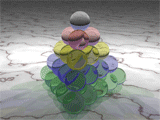Dörtyüzlüsel sayı: Revizyonlar arasındaki fark
Superyetkin (mesaj | katkılar) Yeni sayfa: {{Çeviri}} {{Çalışma var}} [[Dosya:Pyramid of 35 spheres animation.gif|frame|right|Ayrıt uzunluğu 5 birim olan piramit 35 küre içerir. Her katman ilk beş üçgensel sayıyı gö... |
(Fark yok)
|
Sayfanın 08.32, 4 Eylül 2009 tarihindeki hâli
Bu sayfanın ya da bir kısmının Türkçeye çevrilmesi gerekmektedir. Bu sayfanın tamamı ya da bir kısmı Türkçe dışındaki bir dilde yazılmıştır. Madde, alakalı dilin okuyucuları için oluşturulmuşsa o dildeki Vikipedi'ye aktarılmalıdır. İlgili değişiklikler gerçekleşmezse maddenin tamamının ya da çevrilmemiş kısımların silinmesi sözkonusu olabilecektir. İlgili çalışmayı yapmak üzere bu sayfadan destek alabilirsiniz |
Bu sayfada devam eden bir çalışma vardır. Yardım etmek istiyorsanız ya da çalışma yarım bırakılmışsa, çalışmayı yapan kişilerle iletişime geçebilirsiniz. Bu sayfada son yedi gün içinde değişiklik yapılmadığı takdirde şablon sayfadan kaldırılacaktır. En son değişiklik, 14 yıl önce Superyetkin (katkılar | kayıtlar) tarafından gerçekleştirildi (). |
Üçgen piramidal sayı olarak da adlandırılan dörtyüzlü sayı üçgen tabanlı ve üç ayrıtlı bir piramidi temsil eden biçimli sayıdır. n. dörtyüzlü sayı ilk n üçgensel sayının toplamına eşittir.

İlk dörtyüzlü sayıların bir bölümü şunlardır:
n. dörtyüzlü sayı formülü 3. artan faktöriyelin 3. faktöriyele bölümü biçiminde gösterilir.
Tetrahedral numbers are found in the fourth position either from left to right or right to left in Pascal's triangle. The tetrahedral numbers are therefore binomial coefficients:
Tetrahedral numbers can be modelled by stacking spheres. For example, the fifth tetrahedral number (T5 = 35) can be modelled with 35 billiard balls and the standard triangular billiards ball frame that holds 15 balls in place. Then 10 more balls are stacked on top of those, then another 6, then another three and one ball at the top completes the tetrahedron.
A.J. Meyl proved in 1878 that only three tetrahedral numbers are also perfect squares, namely:
- T1 = 1² = 1
- T2 = 2² = 4
- T48 = 140² = 19600.
The only tetrahedral number that is also a square pyramidal number is 1 (Beukers, 1988), and the only tetrahedral number that is also a perfect cube is 1.
Another interesting fact about tetrahedral numbers is that the infinite sum of their reciprocals is 3/2, which can be derived using telescoping series.
The tetrahedron with basic length 4 (summing up to 20) can be looked at as the 3-dimensional analogue of the tetractys, the 4th triangular number (summing up to 10). The tetractys was considered holy by the Pythagoreans.
When order-n tetrahedra built from Tn spheres are used as a unit, it can be shown that a space tiling with such units can achieve a densest sphere packing as long as n ≤ 4 [1].
The parity of tetrahedral numbers follows the repeating pattern odd-even-even-even.
An observation of tetrahedral numbers: T5 = T4 + T3 + T2 + T1
Numbers that are both triangular and tetrahedral must satisfy the binomial coefficient equation:
The following are the only numbers that are both Tetrahedral and Triangular numbers:
Tetrahedron1 = Triangle1 = 1
Tetrahedron3 = Triangle4 = 10
Tetrahedron8 = Triangle15 = 120
Tetrahedron20 = Triangle55 = 1540
Tetrahedron34 = Triangle119 = 7140



